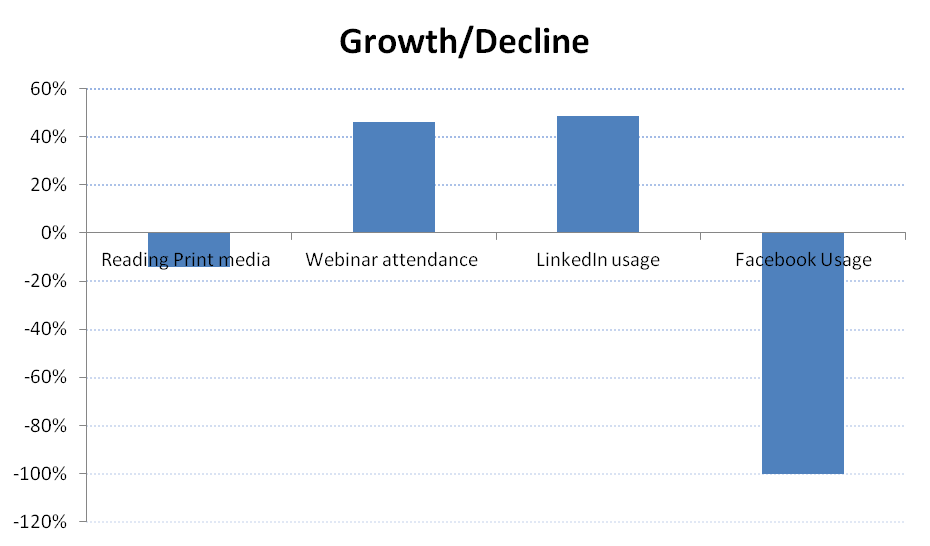Market Connection released its excellent 2012 Federal Media and Marketing Study, which presented facts and figures on how senior Federal decision-makers and employees obtain their news and information. The purpose of the report is to aid subscribers in designing federal marketing campaigns and selecting media outlets that are appropriate to the buyers preferences. I really like the demographics of the report, as 82% are aged 45 or higher, which suggests that these respondents are likely to have lots of authority or influence in their respective agencies.
In various blogs and news releases about the report, the slant on the data suggests that traditional marketing still work and should continue to be used. However, I submit that the facts really demonstrate what we have been saying for some time; firms must adapt to the new world of content marketing, social media marketing and search marketing.
Let’s review some of the widely publicized figures that have emerged from this report.
 Is Print advertising dead? Market Connections states that “Federal decision makers are slowly shifting away from reading trade publications in print, but the decrease from last year is small (40% in 2011 to 35% in 2012). “ However, that represents a double digit decline, in just one year! Frankly, I don’t think print advertising will ever disappear completely, but clearly, it is far less important than just a few years ago and given the cost, would marketing dollars be better invested elsewhere?
Is Print advertising dead? Market Connections states that “Federal decision makers are slowly shifting away from reading trade publications in print, but the decrease from last year is small (40% in 2011 to 35% in 2012). “ However, that represents a double digit decline, in just one year! Frankly, I don’t think print advertising will ever disappear completely, but clearly, it is far less important than just a few years ago and given the cost, would marketing dollars be better invested elsewhere?
 Are Trade Shows and Conferences Worthwhile? Trade shows and conferences still present viable marketing and networking opportunities as more than half of federal decision makers have been attending trade shows. Human connections are always worthwhile, but for some firms, trade shows don’t always represent the best opportunity to connect with potential buyers. If trade shows works for you in the commercial world, they are likely to work with you in the federal market. Of course , for selling services and complex solutions, speaking at a conference is far more effective than merely exhibiting at a trade show. Budget cuts and the recent GSA conference scandal, sadly, will cut into federal travel for training and conferences in the next few years.
Are Trade Shows and Conferences Worthwhile? Trade shows and conferences still present viable marketing and networking opportunities as more than half of federal decision makers have been attending trade shows. Human connections are always worthwhile, but for some firms, trade shows don’t always represent the best opportunity to connect with potential buyers. If trade shows works for you in the commercial world, they are likely to work with you in the federal market. Of course , for selling services and complex solutions, speaking at a conference is far more effective than merely exhibiting at a trade show. Budget cuts and the recent GSA conference scandal, sadly, will cut into federal travel for training and conferences in the next few years.
 Are Webinars worthwhile?– Webinar attendance also increased from 14% to 26%. That’s right, nearly double. And the aforementioned budget cuts may increase webinar attendance even more.
Are Webinars worthwhile?– Webinar attendance also increased from 14% to 26%. That’s right, nearly double. And the aforementioned budget cuts may increase webinar attendance even more.  LinkedIn Still Growing! LinkedIn usage by federal decision makers has nearly doubled, up to 35% from 18% the prior year. LinkedIn is definitely the place for professionals to meet and share ideas.
LinkedIn Still Growing! LinkedIn usage by federal decision makers has nearly doubled, up to 35% from 18% the prior year. LinkedIn is definitely the place for professionals to meet and share ideas.
 Facebook not that important! For B2G marketing, Facebook has not proven all that useful. In fact, the study found that federal professionals use of Facebook is down to 3% from 6% for work-related activity. Yes, Facebook continues to grow for personal use, but for B2G marketing, it’s simply not a viable outlet at this point.
Facebook not that important! For B2G marketing, Facebook has not proven all that useful. In fact, the study found that federal professionals use of Facebook is down to 3% from 6% for work-related activity. Yes, Facebook continues to grow for personal use, but for B2G marketing, it’s simply not a viable outlet at this point.
 Blogging is important. More than one third report that they read blogs (37%). So writing remarkable content continues to be important to engage potential federal professionals. Effective blogging helps establish your firm as a thought leader, build brand, and increase connections.
Blogging is important. More than one third report that they read blogs (37%). So writing remarkable content continues to be important to engage potential federal professionals. Effective blogging helps establish your firm as a thought leader, build brand, and increase connections.

Federal Inbound Marketing is Important
The above figures strongly suggest that incorporating of federal inbound marketing into your overall federal marketing program is essential. For information about federal inbound marketing, which includes content marketing, social media marketing and search marketing, see Federal Inbound Marketing: Social Media and More.
Another aspect that isn’t covered above, pertains to the importance of search marketing. Other studies have shown that when federal employees look for information on solutions to their problems, they use search engines such as Google. GSA did a study not long ago and they found 75% of Feds used search engines for this purpose. What influences how high your firm shows up in search rankings? Search marketing, social media marketing, and content marketing.
For medium and large-sized businesses that can still afford expensive outbound marketing programs like trade shows and print media advertising, they should devise a hybrid model that includes inbound marketing in the mix. For small and smaller medium-size contractors, who need to be smarter about marketing expenditures, federal inbound marketing should be a priority in your B2G marketing strategy in the coming years.
About the Author: Robert Kelly
Robert Kelly is the President and Principal Consultant at TurboGSA, a consultancy thathelp firms expand their federal business with GSA and VA schedule contracts and improvingfederal marketing programs.
Google+




